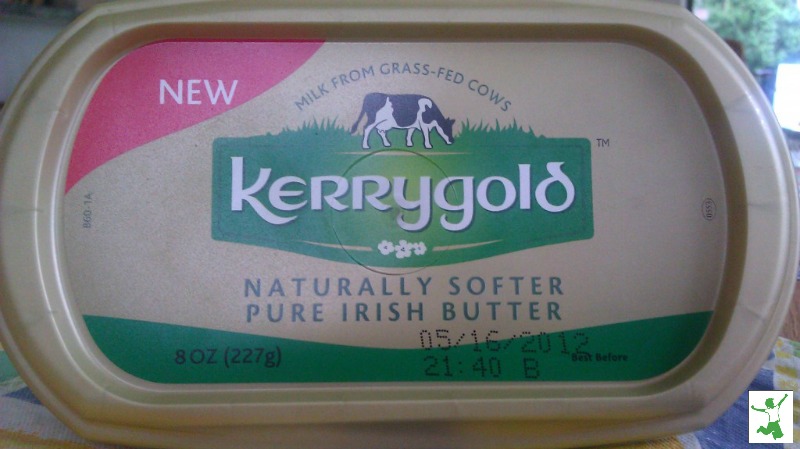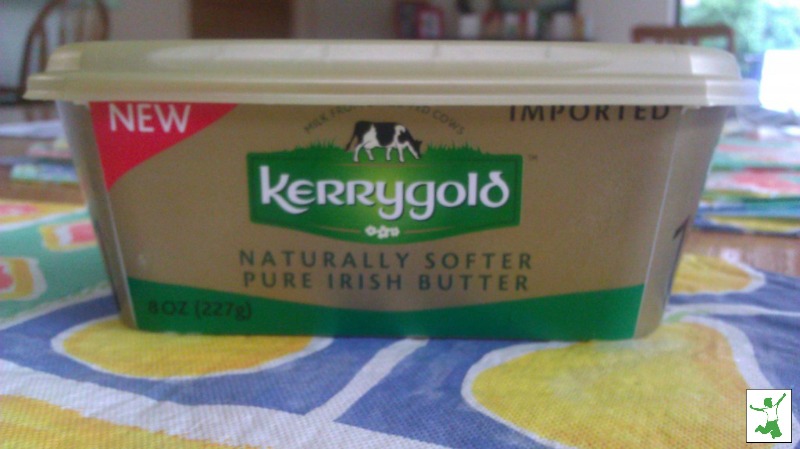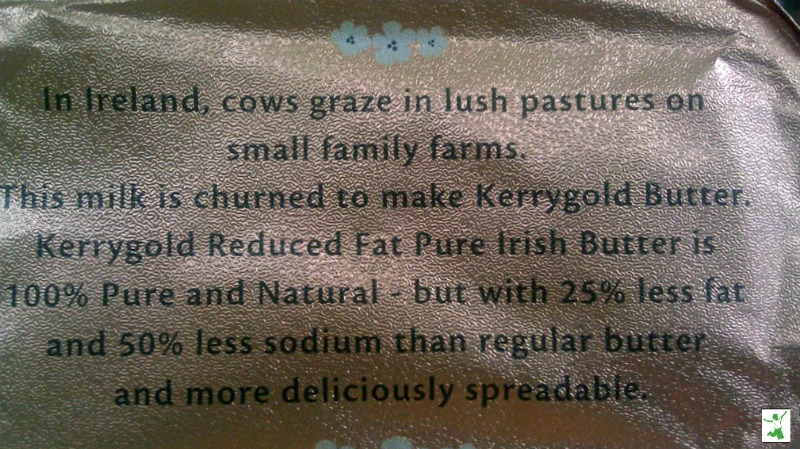Table of Contents[Hide][Show]
Kerrygold is marketed as grass-fed and all-natural, but the tub butter has concerning ingredients, dangers and marketing ploys to consider before buying.

Kerrygold, without question, is probably one of the best store butters you can buy. I myself have been using it for years for cooking.
The milk is from grass-fed cows and even though the cream used to make Kerrygold Butter is pasteurized, it is the best choice available to most folks who do not have access to raw butter from a small farm or who simply don’t want to use their precious raw butter for cooking.
I also know that many of you out there use Kerrygold too. When I conducted a Butter Poll on this blog awhile back, by far the most used butter (out of 1,500 or so total votes) was Kerrygold which received way more votes than even Organic Valley butter.
So what’s the problem?
My husband brought home the “new” Kerrygold butter the other day. On the surface, it looked fine. Nowhere on the outside of the package was there any indication that there was a problem with this butter. Here’s what it looks like.

I got suspicious with the “new” label, however. There’s nothing “new” about butter. That’s what I like about it after all!
Another tip-off that there was a problem lurking was the proclamation on the label that this “New Kerrygold” was “naturally softer”.
When I first saw the “naturally softer” words, I thought that meant that the butter was whipped and hence more spreadable. I don’t know about you, but I don’t want air whipped into my butter. This is a surefire way to get less product and get charged the same price for the privilege if you know what I mean.
I made a mental note to tell my husband not to buy this butter again because it was whipped and not as good a value.
But then, it got way worse…
Is Kerrygold Butter Grass-fed?
I took off the lid to the new Kerrygold package and saw the following words:

I had become a victim of the Big Fast One!
Kerrygold is stealthily selling LOWFAT butter and guess what? You get to pay the same price for the cheaper quality!
NOWHERE on the outside of the label did it say that the butter was low-fat. The ingredients said simply: pasteurized cream and salt the same as the commercialized Amish butter at the supermarket.
I daresay that this marketing ploy will be fooling a lot of folks who desire to buy full-fat grass-fed butter.
It seems that some butter brands have adopted what companies making substitutes for butter have been doing for years.
I have become very tuned in to these labeling tricks and manufacturer games over the years. When it comes to packaging, I double-check the ingredients along with the manufacturing processes every few months. This is even for products that I’ve been buying for years.
But how many people really do this?
Ingredient Bait and Switch
You NEED to be doing this!
Manufacturers are changing ingredients and packaging all the time! The primary intent of these “improvements” is to increase product sales and profitability. Your health is, sadly, of little to no concern in the grand scheme of things.
Reducing the fat content in its butter will skyrocket profits for Kerrygold as they will make the same per unit for the butter and yet be able to sell the skimmed cream to other companies to make ice cream or whatnot thereby increasing revenue substantially.
If you buy Kerrygold, I’m not telling you to stop buying it. I’m only telling you to beware of this new packaging nonsense and be sure what you buy is what you intend: full-fat butter!
By the way, if you are wondering why I love full-fat butter, you might want to educate yourself on the low-fat scam by learning about the history of butter vs margarine in the United States.
As for me, I will be returning this product to the store for a full refund. It is falsely advertised after all. I had no way of knowing it was a low-fat product until I opened it.
Manufacturer Response
I received this email from Kerrygold following the widespread sharing of this article. I find it very hard to believe that my blog suddenly brought this packaging error to their attention.
Do they have NO ONE on the production line in charge of quality control? This was not a difficult problem to identify. Could we have a bit of spin going on here? Perhaps so.
Dear Sarah,
Your blog has brought to our attention a packaging error of which we were unaware. While Kerrygold does sell a Reduced Fat & Sodium Butter the pack you show on your blog is 100% full fat butter which has been packed with the incorrect inner seal. There is no deliberate intent on our part to mislead our valued consumers or to misrepresent our product although we regret the confusion this is clearly creating.
We are working to identify how much product has been released into the market with the incorrect packaging so that we can replace it as soon as possible. In the meantime we would appreciate your assistance in clarifying the misunderstanding to your readers. We would love to provide further clarity — our email is [email protected] — and we are happy to answer any specific questions you and your readers may have in relation to the product.
With thanks & regards,
The Kerrygold Team
Why I No Longer Buy Kerrygold
I wanted to let all of you know that I no longer buy even the traditional Kerrygold brick butter in foil packaging. Why? A good friend visited Ireland and traveled extensively to a number of grass-based dairy farms.
This credible source told me that while the cows that provide cream for the Kerrygold butter are definitely on pasture and hence “grass-fed”, they receive supplemental GMO animal feed as well especially during the winter months. The local community and citizenry in Ireland concur and will tell you as much if you are in the area.
So, the word on the street is that Kerrygold is not legitimately pastured either.
Butter from cows that get GMO feed introduces the very real possibility of Roundup residue in the butter.
Thanks but no thanks!
While I have not been able to confirm this story 100%, I trusted the credibility of the information enough to permanently switch to another brand (I currently use this one).
I use this butter for cooking in addition to the homemade pastured raw butter I make for non-cooking purposes.
I also no longer recommend Kerry Gold in my Shopping Guide.
What about Organic Valley butter as an alternative to Kerry Gold? While I am not happy about Organic Valley’s policy that disallows member farmers to sell raw milk on the side to their community (treating them more like medieval serfs than the independent business owners that they are), I find this less onerous than deceptively feeding animals GMO feed without clearly informing the end consumer.









I just bought a couple tubs of this butter from Costco yesterday because they didn’t have the bricks anymore and Kerrygold is the best quality butter I have access to right now. While I’m not happy about the new packaging (it makes it much more difficult to measure and bake with), I think this post was a bit rash and that it was just a simple mistake. My tub says on the ingredients simply “cream and salt” – and on the foil on the inside, it explains that it is softer because of the summer milk used and the gentle churning process used. My tub is just as yellow and tasty as all of the other Kerrygold butter I have purchased, so I will keep buying it. I just hope Costco brings back the bricks for my baking!
Ask Costco to carry it; that has often seen them get in a product that I’m looking for. By the way…this soft product is specifically for spreading, not for baking. It’s not meant to be a substitute for their regular product Kelsey so I hope you can get it back at your Costco!
Barbara: It is interesting but indeed Costco can be responsive to consumer requests, considering how big-box a place that is. You aren’t the first I’ve heard where they responded positively. (But such response may well be erratic, too…)
The Kerrygold Butter in the foil package that I bought from Trader Joe’s in early October is different, too. I noticed the difference and wondered about it just looking at the packages in the store. They looked flat and hard with sharp, precise edges, rather than the more rounded, softer looking packages previously. The butter itself seems harder than the Kerrygold I’ve been buying for over three years. Every time I’ve used it this last month, I’ve wondered what the difference is. I still don’t know for sure, but have thought the high fat content is what made Kerrygold softer and more easily spreadable right out of the refrigerator than other butters I’ve tried, and so have wondered if that was changed. Now this news about the fat content of the tub version, especially coming at the same time, has caused me to suspect even more that the fat content may have been altered. At any rate, something is noticeably different about this Kerrygold butter.
I believe them when they say it was a packaging mistake. Someone loaded the wrong foils into the machine and nobody saw it because the lids are most likely put on immediately afterward and nobody ever sees it. Mistakes happen. Kerrygold is a good brand and they’re not going to risk their reputation by doing this deliberately. I like a good conspiracy as much as the next person, but this just reads as a mistake to me. Doesn’t matter to me really, my butter is Icelandic.
I had a heck of a time trying to extract information from Kerrygold via email a few months ago. All I wanted to know was ~Did the cows eat ANYTHING besides grass?~ You wouldn’t BELIEVE the run around I received. I think we exchanged 5 emails before I FINALLY got an straight answer. I was tempted to call, but I like to get my answers in email form for later reference. I’m still not convinced… I do know that many different farmers raise the cows who provide the milk for the butter.
I haven’t read the replies yet – I just got home. But I wanted to say that I think this WAS an honest mistake.
I was just in the store and compared this one (that you have pictured) with the one with the blue label that DOES say on the OUTSIDE they are less fat and salt. It says it’s 7g fat, as opposed to 11g’s in their regular butter. This same tub you have pictured DOES have the 11g’s fat, not 7. It was an honest mistake.
I am a label-reader, and I peeled off the foil and tossed it without seeing what you did.
Good eye! But It’s still good butter.
However, I do wonder why it’s naturally soft. I keep my butter on the counter and it’s usually pretty firm this time of year.
Typing from those lush green pastures in the emerald isle…what can I say?? Kerrygold is sold all over the world and marketed as the wonderful wholesome product all Irish images conjure up. In comparison to Commercial feedlot farms yes the cows do feed on lush grass here. However the grass is not necessarily as lush as I would like… The use of artificial fertilizers and monoculture rye grasses that are easy to grow are commonplace. Its a compromise though i buy it myself and use it. Just don’t assume we all milk contented cows by hand here as we frolik through the herb scented meadows in our spare time! The Kerry group is a very successful one. Respect to them for what they have achieved but its no harm to keep a very open mind as a consumer and educate yourself to the reality of compromises that must be made to facilitate massive food distribution (and profit margins..!) Now I’ll have some butter for my grainfree Irish brown bread…!
Please stop the drama ! This is the last useless drama queen infused post of yours ill read. Good day!
Sarah it seems that it is a labelling mistake after all; I was in another EU country the other day (I live in Greece but I cannot find Kerrygold butter here, only the cheeses) and happen to find myself in a supermarket and notice the Kerrygold butter you have in the picture above.
I opened the package but the inner seal was empty, unlike yours.
But still I prefer the Devon Devon Cream Butter. I buy the Kerrygold one only for baking as it so much cheaper.
This is to KerryGold through you Sarah – Let them, unequivocally, let us know what action they took to correct this ‘unfortunate error’. Did they withdraw all the mislabeled butter?, did any heads roll in their production facility?
I have been involved in Industrial production too long to believe their baloney, they are just trying to make up a story now that they have been caught red handed.
The label was a mistake. They do have a version that is 25% less fat and that is 7g’s. This is still 11g’s.
Wow, 199 comments already!
OK, I do think this was a packaging mistake, but here’s the kicker: Isn’t it ILLEGAL to sell a food item with improper ingredients / nutrition fact labels? Not that I trust the FDA / USDA, but I actually do believe in listing all ingredients and the nutrition facts. So, either this was an accident and there is REAL full-fat butter in a “reduced-fat” container – in which a person on a “prescribed” low-fat diet can sue over, or it is a low-fat butter in a new container that does not say that (your container is different than the pic on their website). Either way, selling that product in the USA is ILLEGAL – it is falsely labelled and should be RECALLED immediately! Packaged food must by law contain what the package says it contains!
Why sell “reduced fat” butter? BLAME DENMARK!!! They are now TAXING REAL BUTTER, so this is probably what caused this imposter “butter” addition!
Now, how do you get reduced-fat butter? Well, first of all, REAL butter does not contain milk – it contains the CREAM ONLY! On their website it says the reduced-fat version is made from the “MILK” from the same cows!!! So, now I want to know what the lactose / casein content is!
OK, assuming they recall the mis-labelled products, here is a tip: First read the ingredients, and then read the NUTRITION FACTS LABEL and compare the FAT CONTENT to real butter. That is how I decide if one product is better than another – I buy the higher total and saturated fat content.
As for Stonyfield – FORGET IT!!! I live in the Northeast and will support products made up here over those made elsewhere whenever I get the chance. The vast majority of dairy farms up here are small family farms and the cows still graze grass all the time. That being said, although Stonyfield claims a New Hampshire legacy, their products are ALL ULTRA-PASTEURIZED and they recently helped approved GMO Alfalfa (along with Whole Foods). Even though they are not organic, I support Chobani Greek Yogurt made from hormone-free NY cow’s milk, and Cabot Creamery Cheese made from hormone-free cows from VT, NY and other New England states. Stonyfield is now too big for it’s own britches – it’s more like Horizon “Organic” nowadays.
BTW: Lurpak Danish butter is GROSS!!! It is SO NOT made from Grass-fed cows – it is just super-expensive conventional butter! It is not yellow like Kerrygold. I haven’t tried the Smjor yet (except when in Iceland), but where do those cows live / graze? The reason Irish butter is so good is because the native cows from Ireland and nearby islands have the highest fat content of all other cows (Dexter, Jersey, Guernsey), and because lush grass grows throughout Ireland naturally without any human input. That cannot be said for Mainland Europe or the USA.
BTW: In grocery stores, check the deli / fancy cheese section for Kerrygold. I couldn’t find it in the butter / dairy section of a big chain (Stop n Shop), and that’s because it is in the imported cheese section near the fresh bread and other stuff. It costs $5 everywhere near me except the local market where it costs only $3.50 for an 8oz. block, so I make sure to go once a month and buy like 4 – 6 blocks just so they keep carrying it (they no longer carry So Delicious Coconut Milk – replaced by Silk – YUCKKK!) Also, I find that the normal block version of Kerrygold is softer than conventional butter blocks, so I don’t see a need for the tub version (whereas I did always use “whipped” conventional butter for spreading before I switched to KG).